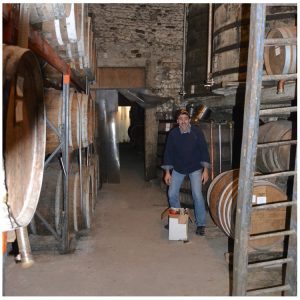The Role of Cellar Masters
Probably only the big cognac houses have imported cellar masters. Usually they are recruited from family firms whose skills and experience have, over the years, kept the industry in very good form. Currently most cellar masters are male so, whilst explaining the role, I will use the pronoun ‘he’.

In truth, the cellar master is a multi-skilled person whose understanding of the cognacs in his cellar starts with the fresh eau de vie. He needs to understand how it was made, including the quantities distilled, the distillation temperature and when the cut was made. This information will help him choose the correct barrels to use for both the initial storage and the long barrel ageing in his cellar. Most cognac houses have their own style of cognacs, normally recognisable by experts. He will try to replicate that style throughout his cognacs.
Modern cognacs are usually made for blending. To do this they are poured out of their barrels into large wooden tanks which may hold as much 100,000 litres. Blending is a complex job and much emphasis is placed on the knowledge gained from the cellar’s historical background. Mixing cognacs requires a great deal of experience. It does not follow that mixing two fine cognacs together will produce something of a similar quality. In some cases, especially when very high quality eaux de vie is used, the quality of the final blend is a total disaster.
The cellar master’s role also includes an in-depth understanding of his barrels – their size, the oak used and what they have previously contained (the second stage of ageing is always in old barrels). He also needs to understand how much they were toasted and where he is going to keep them. Many cellar masters move their barrels around the cellar to make full use of the humidity and to keep the cognac moving so it is exposed to every part of the barrel.
Lastly, he tests the cognac by taking samples and checking the level of alcohol. This is done by measuring the temperature and using an alcohol meter. All official alcohol measurements are made at 20 degrees Celsius, so it is important to be able to calculate the actual strength at different temperatures. Small samples are taken to gauge the cognac’s maturity and balance at regular intervals as each barrel produces a cognac with a slightly different flavour and colour. The skill of bringing all these properties together takes many years to learn. It is for this reason that the cognacs produced by family firms are often of a far higher quality than those from the big houses, which are highly blended.
